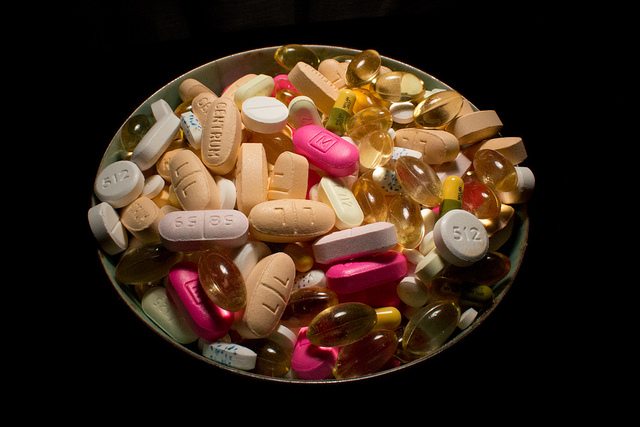
Drugs and supplements may look similar, but they are held to very different quality standards.
Most of the readers of this blog are fortunate to live in countries where we don’t have to worry about counterfeit drugs, as long as we’re shopping at regulated pharmacies. We can be confident that the prescription we receive, or the over-the-counter drugs we purchase from a pharmacy are of high quality and contain exactly what’s on the label. But in these same countries (and sometimes in these same pharmacies), there’s another group of products where the risks of mislabeled or contaminated products is significant – it’s among the dietary supplements that are often found on the same shelves. In many countries, the manufacturing, distributing, and marketing of dietary supplements is subject to a completely different set of regulations than what is in place for drugs.
Looking specifically at the United States, it is worth repeating that this weakly-regulate marketplace is here by design. The Dietary Supplement Health and Education Act of 1994 (DSHEA) was an amendment to the U.S. Federal Food, Drug and Cosmetic Act that established the American regulatory framework for dietary supplements. It effectively excludes manufacturers of these products from virtually all regulations that are in place for prescription and over-the-counter drugs, and puts the requirement to demonstrate harm on the FDA, rather than the onus on the manufacturer to show a product is safe and effective. The goal was to eliminate barriers to sale, and it worked: Within four years of the DSHEA, supplement sales grew from $4 billion to $12 billion, and is now estimated at over $55 billion per year.
The absence of good product quality standards is a persistent barrier to the science-based use of supplements. With drugs, the standards are rigorous and largely consistent across countries: Drugs are approved after clinical trials are conducted to show they have meaningful effects. These clinical trials are scrutinized by regulators. Products that are approved for sale must be shown to be equivalent to the product studied in the clinical trials. This allows us to extrapolate the findings from research into expected effects in patients. And manufacturers must meet stringent quality standards for their products, including verifying the consistency and quality of what they produce. The same can’t be said for supplements. Even if there is promising data from clinical trials, we can’t make the same inference about the expected effects, because there is not guarantee that a supplement for sale is identical to (or even closely similar to) another product.
A new research letter in JAMA Network Open adds more data to other studies that have raised questions about supplement manufacturing quality. From Pieter Cohen and colleagues, the paper is titled Presence and Quantity of Botanical Ingredients With Purported Performance-Enhancing Properties in Sports Supplements and was published on July 17, 2023. The authors explain that since the FDA banned ephedra from dietary supplements in 2004, manufacturers have tried to come up with a variety of supplements to provide stimulant or anabolic effects all while remaining classified as “supplements” and not drugs. The specifically sought to determine the accuracy of products that were said to contain Rauwolfia vomitoria, methylliberine, the halostachine, turkesterone, and octopamine. All of these ingredients can be naturally sourced and are promoted for sports stimulant effects.
Sixty-three products were purchased online. Six of these products did not list one of the five ingredients above, so 57 products remained to be analyzed. Twenty-three of the 57 products (40%) did not contain any detectable amount of the labeled ingredient. Among the other products, the actual content ranged from 0.02% to 334% of the label’s stated quantity. Only six products (11%) contained ingredients within 10% of the stated labelled standard. Seven of the 57 products were found to contain at least one FDA-prohibited ingredient, an unapproved drug available legally only in Russia (omberacetam), three drugs formerly available in Europe (ioctodrine, oxilofrine, and deterenol), and incredibly, one drug that has never been approved in any country (1,4-dimethylamylamine). The full table of analysis can be found here.
An analysis that I wrote about back in 2018 identified that supplement adulteration (with prescription drugs) seemed to be concentrated in products like erectile dysfunction supplements, weight loss supplements, and muscle building/bodybuilder supplements. This analysis provides new data that shows that dietary supplements marketed as sports supplements appear to be manufactured to terrible quality control standards.
Buyer Beware
Both users and critics of dietary supplements should agree that products need to be manufactured to high quality standards. We need regulation from a consumer protection perspective, if only to ensure we’re getting what we’re paying for. Weak regulation that doesn’t require manufacturers to demonstrate quality before products are sold, or fails to hold manufacturers to account when things go wrong, might be expected to result in poor-quality products. And that’s the reality with supplements today.
A lowered regulatory bar for dietary supplements has been a boon to the industry, but the same can’t be said for consumer protection. In the absence of regulation that puts safety ahead of manufacturer interests, we shouldn’t expect to see any meaningful improvements in product quality. This double-standard has made it harder, rather than easier, for consumers to use supplements safely. Until a single, rigorous standard is applied across all consumer health products, there will continue to be uncertainty and even safety risks for users of dietary supplements.

